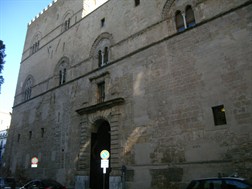The seat of the tribunal: Palazzo Steri
 From 1601 until 1782 the seat of the Tribunal de la Suprema y General Inquisición was a beautiful building that still now dominates the Piazza Marina: Palazzo Chiaromonte or Palazzo Steri, from the latin hosterium, fortified palace (picture). Until 1601, the Inquisition in Palermo changed several times its seat: from the house of the royal engraver Juan Chilestro, whose stores could serve as prisons, it passed between the XV and the XVII century in the seized home of Giovanni Battista De Rosa, which was provided of wineries; then, the inquisitors forced the viceroy to live in the Castello a mare, a fortress on the coast of Palermo, and to leave the Palace of the Normans; also unhappy with this arrangement, they moved to Castel San Pietro and then they again transferred the viceroy to occupy the Castello a mare. The reason for this restlessness is due to the fact that the environments were always not adapted to the work of the Inquisition: the private houses were not spacious enough, fortresses – where, however, the soldiers of the viceroy had to remain to do patrols and exercises – did not ensure the secrecy that the inquisitors wanted to enjoy. When, in the Castello a mare, the powder-magazine blew up, killing hundred of prisoners and wounding the Inquisitor Ludovico Paramo, they decided to transfer again. On 30 January 1597 the inquisitors informed their superiors in Madrid they wanted the so-called Casa del Hoster or Aduana, at that time the seat, however, of the President of the High Court (Gran Corte) – the highest court in the Vicereign – Vincenzo Rao, the great opponent of the Inquisition: the request was accepted. So in 1601, the tribunal moved into the palace built centuries before with great deal of money by the rich and powerful Chiaramonte family, which had lost its power and influence at the end of the XV century.
From 1601 until 1782 the seat of the Tribunal de la Suprema y General Inquisición was a beautiful building that still now dominates the Piazza Marina: Palazzo Chiaromonte or Palazzo Steri, from the latin hosterium, fortified palace (picture). Until 1601, the Inquisition in Palermo changed several times its seat: from the house of the royal engraver Juan Chilestro, whose stores could serve as prisons, it passed between the XV and the XVII century in the seized home of Giovanni Battista De Rosa, which was provided of wineries; then, the inquisitors forced the viceroy to live in the Castello a mare, a fortress on the coast of Palermo, and to leave the Palace of the Normans; also unhappy with this arrangement, they moved to Castel San Pietro and then they again transferred the viceroy to occupy the Castello a mare. The reason for this restlessness is due to the fact that the environments were always not adapted to the work of the Inquisition: the private houses were not spacious enough, fortresses – where, however, the soldiers of the viceroy had to remain to do patrols and exercises – did not ensure the secrecy that the inquisitors wanted to enjoy. When, in the Castello a mare, the powder-magazine blew up, killing hundred of prisoners and wounding the Inquisitor Ludovico Paramo, they decided to transfer again. On 30 January 1597 the inquisitors informed their superiors in Madrid they wanted the so-called Casa del Hoster or Aduana, at that time the seat, however, of the President of the High Court (Gran Corte) – the highest court in the Vicereign – Vincenzo Rao, the great opponent of the Inquisition: the request was accepted. So in 1601, the tribunal moved into the palace built centuries before with great deal of money by the rich and powerful Chiaramonte family, which had lost its power and influence at the end of the XV century.
The settlement of the tribunal in the palace made necessary substantial changes, such as the construction of new spaces for the prisoners. Today, to learn about the building and the institution that employed it we will have an exceptional guide: a person under investigation.
